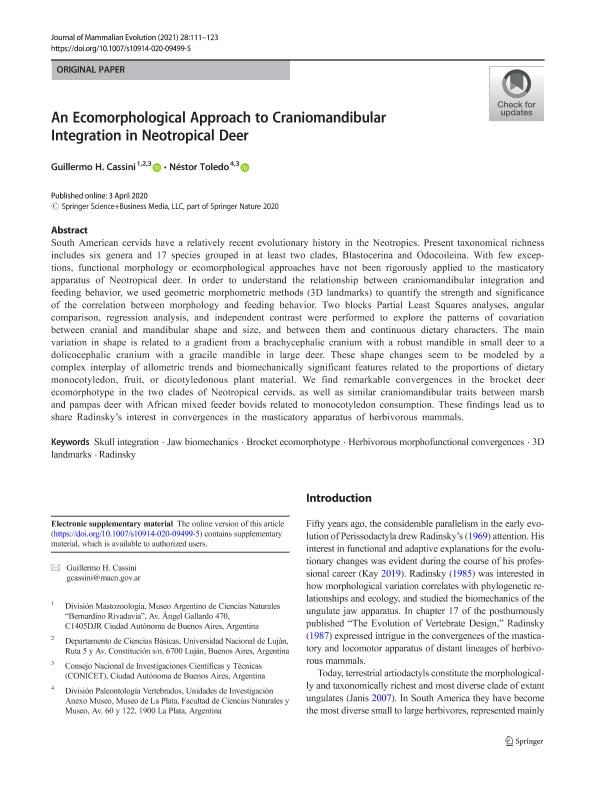Mostrar el registro sencillo del ítem
dc.contributor.author
Cassini, Guillermo Hernán

dc.contributor.author
Toledo, Néstor

dc.date.available
2021-06-08T12:22:44Z
dc.date.issued
2021-03
dc.identifier.citation
Cassini, Guillermo Hernán; Toledo, Néstor; An Ecomorphological Approach to Craniomandibular Integration in Neotropical Deer; Springer; Journal of Mammalian Evolution; 28; 1; 3-2021; 111-123
dc.identifier.issn
1064-7554
dc.identifier.uri
http://hdl.handle.net/11336/133391
dc.description.abstract
South American cervids have a relatively recent evolutionary history in the Neotropics. Present taxonomical richness includes six genera and 17 species grouped in at least two clades, Blastocerina and Odocoileina. With few exceptions, functional morphology or ecomorphological approaches have not been rigorously applied to the masticatory apparatus of Neotropical deer. In order to understand the relationship between craniomandibular integration and feeding behavior, we used geometric morphometric methods (3D landmarks) to quantify the strength and significance of the correlation between morphology and feeding behavior. Two blocks Partial Least Squares analyses, angular comparison, regression analysis, and independent contrast were performed to explore the patterns of covariation between cranial and mandibular shape and size, and between them and continuous dietary characters. The main variation in shape is related to a gradient from a brachycephalic cranium with a robust mandible in small deer to a dolicocephalic cranium with a gracile mandible in large deer. These shape changes seem to be modeled by a complex interplay of allometric trends and biomechanically significant features related to the proportions of dietary monocotyledon, fruit, or dicotyledonous plant material. We find remarkable convergences in the brocket deer ecomorphotype in the two clades of Neotropical cervids, as well as similar craniomandibular traits between marsh and pampas deer with African mixed feeder bovids related to monocotyledon consumption. These findings lead us to share Radinsky’s interest in convergences in the masticatory apparatus of herbivorous mammals.
dc.format
application/pdf
dc.language.iso
eng
dc.publisher
Springer

dc.rights
info:eu-repo/semantics/openAccess
dc.rights.uri
https://creativecommons.org/licenses/by-nc-sa/2.5/ar/
dc.subject
3D LANDMARKS
dc.subject
BROCKET ECOMORPHOTYPE
dc.subject
HERBIVOROUS MORPHOFUNCTIONAL CONVERGENCES
dc.subject
JAW BIOMECHANICS
dc.subject
RADINSKY
dc.subject
SKULL INTEGRATION
dc.subject.classification
Zoología, Ornitología, Entomología, Etología

dc.subject.classification
Ciencias Biológicas

dc.subject.classification
CIENCIAS NATURALES Y EXACTAS

dc.title
An Ecomorphological Approach to Craniomandibular Integration in Neotropical Deer
dc.type
info:eu-repo/semantics/article
dc.type
info:ar-repo/semantics/artículo
dc.type
info:eu-repo/semantics/publishedVersion
dc.date.updated
2021-06-04T17:03:24Z
dc.journal.volume
28
dc.journal.number
1
dc.journal.pagination
111-123
dc.journal.pais
Alemania

dc.description.fil
Fil: Cassini, Guillermo Hernán. Consejo Nacional de Investigaciones Científicas y Técnicas. Oficina de Coordinación Administrativa Parque Centenario. Museo Argentino de Ciencias Naturales "Bernardino Rivadavia"; Argentina. Universidad Nacional de Luján; Argentina
dc.description.fil
Fil: Toledo, Néstor. Consejo Nacional de Investigaciones Científicas y Técnicas. Centro Científico Tecnológico Conicet - La Plata; Argentina. Universidad Nacional de La Plata. Facultad de Ciencias Naturales y Museo. Departamento Científico de Paleontología de Vertebrados; Argentina
dc.journal.title
Journal of Mammalian Evolution

dc.relation.alternativeid
info:eu-repo/semantics/altIdentifier/url/http://link.springer.com/10.1007/s10914-020-09499-5
dc.relation.alternativeid
info:eu-repo/semantics/altIdentifier/doi/http://dx.doi.org/10.1007/s10914-020-09499-5
Archivos asociados
